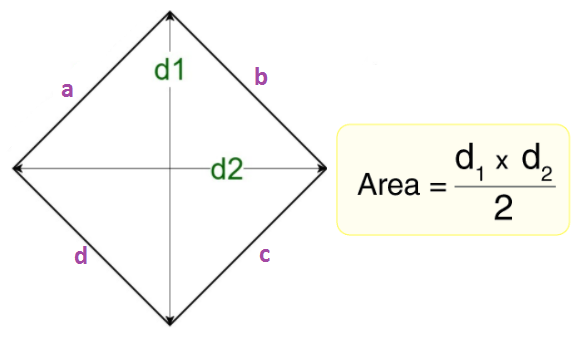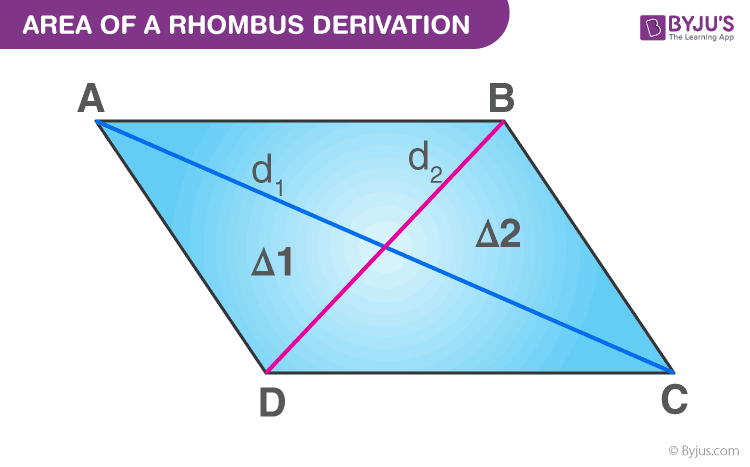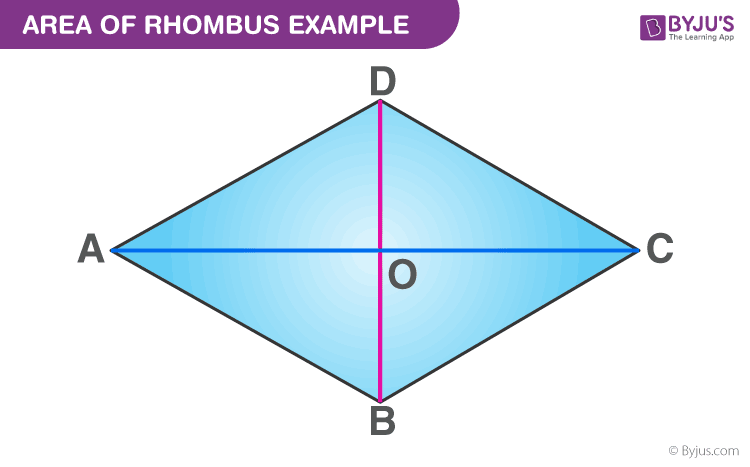Area Of Rhombus
What is the Area of a Rhombus?
The area of a rhombus can be defined as the amount of space enclosed by a rhombus in a two-dimensional space. To recall, a rhombus is a type of quadrilateral projected on a two dimensional (2D) plane, having four sides that are equal in length and are congruent.
Read: Mathematics for grade 10
Area of Rhombus Formula
Different formulas to find the area of a rhombus are:
| Formulas to Calculate Area of Rhombus | |
|---|---|
| Using Diagonals | A = ½ × d1 × d2 |
| Using Base and Height | A = b × h |
| Using Trigonometry | A = b2 × Sin(a) |
Where,
- d1 = length of diagonal 1
- d2 = length of diagonal 2
- b = length of any side
- h = height of rhombus
- a = measure of any interior angle

Derivation for Rhombus Area Formula
Consider the following rhombus:

Let O be the point of intersection of two diagonals AC and BD.
The area of the rhombus will be:
A = 4 × area of ∆ AOB
= 4 × (½) × AO × OB sq. units
= 4 × (½) × (½) d1 × (½) d2 sq. units
= 4 × (1/8) d1 × d2 square units
= ½ × d1 × d2
Therefore, the Area of a Rhombus = A = ½ × d1 × d2
Where d1 and d2 are the diagonals of the rhombus.
Try This: Area of Rhombus Calculator
How to Calculate Area of Rhombus?
The methods to calculate the area of a rhombus are explained below with examples. There exist three methods for calculating the area of a rhombus, they are:
- Method 1: Using Diagonals
- Method 2: Using Base and Height
- Method 3: Using Trigonometry
Area of Rhombus Using Diagonals: Method 1
Consider a rhombus ABCD, having two diagonals, i.e. AC & BD.
- Step 1: Find the length of diagonal 1, i.e. d1. It is the distance between A and C. The diagonals of a rhombus are perpendicular to each other by making 4 right triangles when they intersect each other at the centre of the rhombus.
- Step 2: Find the length of diagonal 2, i.e. d2 which is the distance between B and D.
- Step 3: Multiply both the diagonals, d1, and d2.
- Step 4: Divide the result by 2.
The resultant will give the area of a rhombus ABCD.
Let us understand more through an example.
Example 1: Calculate the area of a rhombus having diagonals equal to 6 cm and 8 cm.
Solution:
Given that,
Diagonal 1, d1 = 6 cm
Diagonal 2, d2 = 8 cm
Area of a rhombus, A = (d1 × d2) / 2
= (6 × 8) / 2
= 48 / 2
= 24 cm2
Hence, the area of the rhombus is 24 cm2.
Area of Rhombus Using Base and Height: Method 2
- Step 1: Find the base and the height of the rhombus. The base of the rhombus is one of its sides, and the height is the altitude which is the perpendicular distance from the chosen base to the opposite side.
- Step 2: Multiply the base and calculated height.
Let us understand this through an example:
Example 2: Calculate the area of a rhombus if its base is 10 cm and height is 7 cm.
Solution:
Given,
Base, b = 10 cm
Height, h = 7 cm
Area, A = b × h
= 10 × 7 cm2
A = 70 cm2
Area of Rhombus Using Trigonometry: Method 3
- Step 1: Square the length of any of the sides.
- Step 2: Multiply it by Sine of one of the angles.
Let us see one example.
Example 3 Calculate area of a rhombus if the length of its side is 2 cm and one of its angle A is 30 degrees.
Solution:
Given,
Side = s = 2 cm
Angle A = 30 degrees
Square of side = 2 × 2 = 4
Area, A = s2 × sin (30)
A = 4 × 1/2
A = 2 cm2
Practice Question Based on Area of Rhombus Formula
Question 1: Find the area of the rhombus having each side equal to 17 cm and one of its diagonals equal to 16 cm.
Solution:

Area of Rhombus Example Question
ABCD is a rhombus in which AB = BC = CD = DA = 17 cm
Diagonal BD = 16 cm (with O being the diagonal intersection point)
Therefore, BO = OD = 8 cm
In ∆ AOD,
AD2 = AO2 + OD2
⇒ 172 = AO2 + 82
⇒ 289 = AO2 + 64
⇒ 225 = AO2
⇒ AO = 15
Therefore, AC = 2 × AO
= 2 × 15
= 30 cm
Now, area of rhombus
= ½ × d1 × d2
= ½ × 16 × 30
= 240 cm2
More Topics Related to Rhombus Area:
| Construction Of Rhombus | Rhombus Lines of Symmetry |
| Rhomboid | Special Parallelograms: Rhombus, Square & Rectangle |
| Difference Between Rhombus and Parallelogram | Difference Between Square & Rhombus |
Frequently Asked Questions
What is a Rhombus?
A rhombus is a type of quadrilateral whose opposite sides are parallel and equal. Also, the opposite angles of a rhombus are equal and the diagonals bisect each other at right angles.
What is the Formula for Area of a Rhombus?
To calculate the area of a rhombus, the following formula is used:
A = ½ × d1 × d2
How to Find the Area of a Rhombus When the Side and Height are Given?
To find the area of a rhombus when the measures of its height and side are given, use the following formula:
A = Base × Height
What is the Formula for Perimeter of a Rhombus?
The formula to calculate the perimeter of a rhombus of side “a” is:
P = 4a units